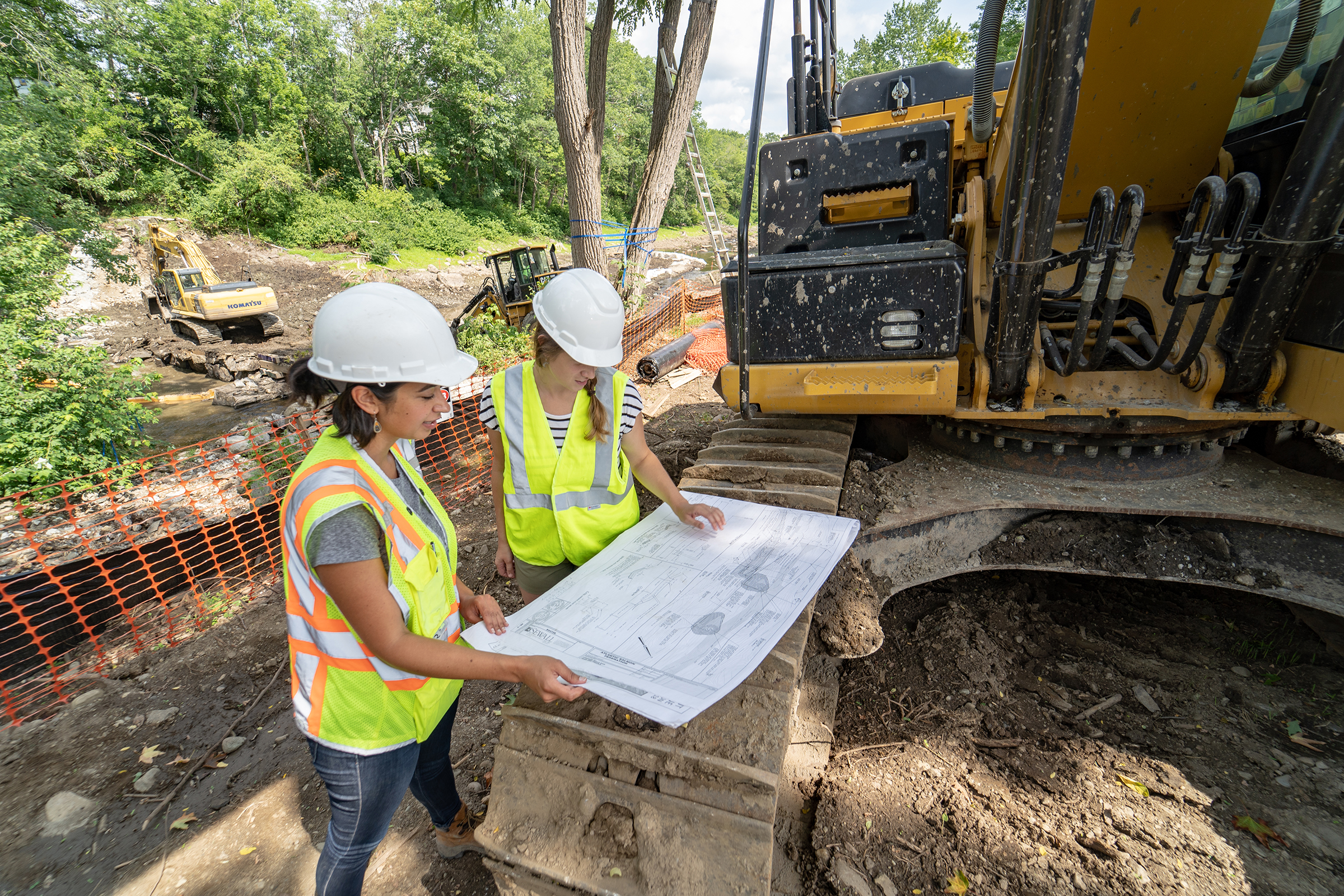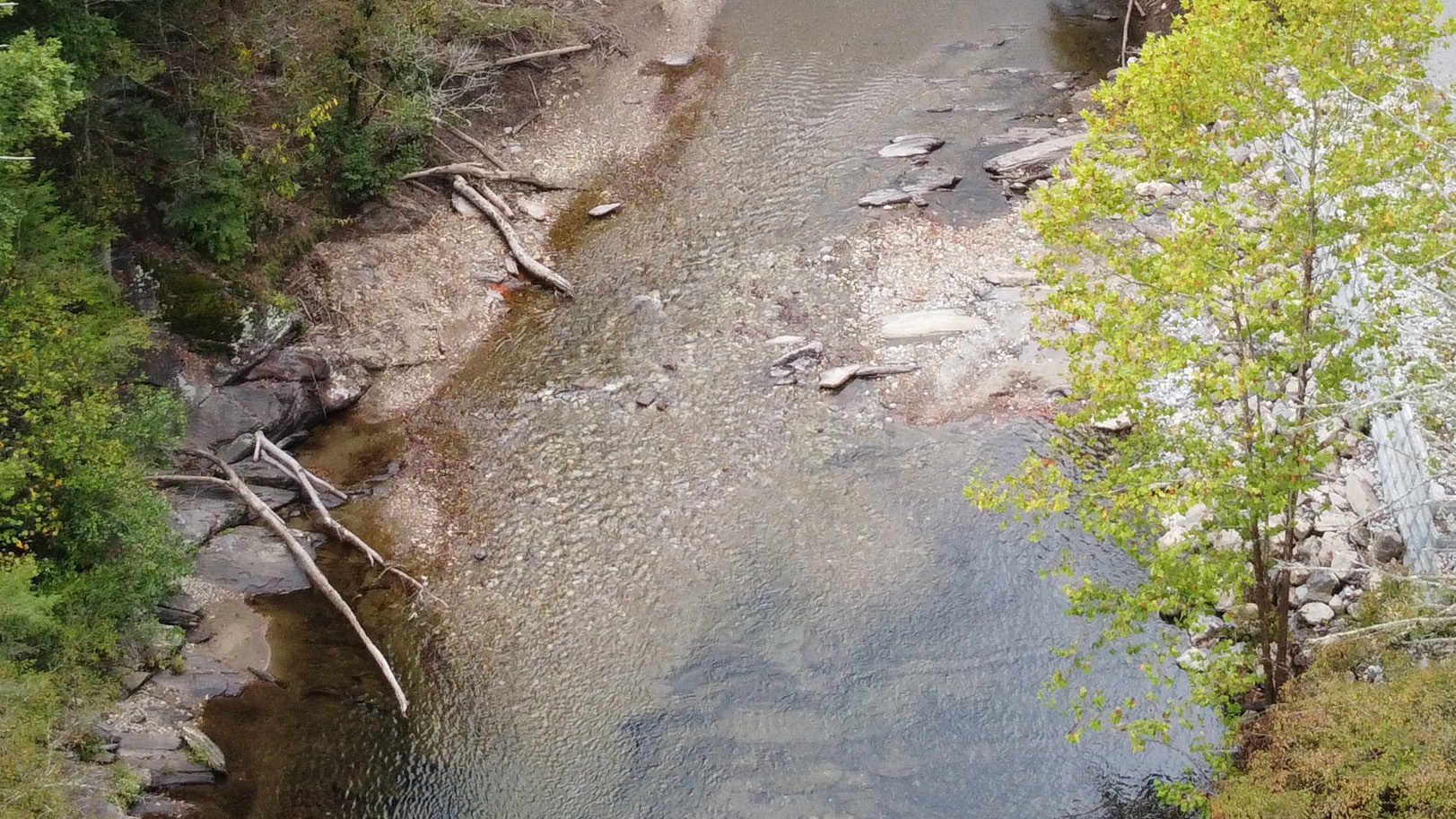Removing Barriers to Reconnect Rivers
Clean, healthy rivers not only support fish and wildlife, they can provide inexpensive, no-carbon energy, along with jobs and recreational opportunities.

Maintaining the Flow A river runs through a New Hampshire forest. © Jerry and Marcy Monkman/EcoPhotography.com
Appalachian rivers and streams are home to remarkable biodiversity—more than half of all North American aquatic species live here. They provide refuge for cold-water fish species as the climate warms, supply the drinking water for more than 36 million people across the eastern United States, and are vitally important to many Indigenous Peoples and local communities for cultural practices and recreational and economic opportunities.
Yet Appalachian waterways are under enormous pressure. Development and agricultural activities have severed streams and rivers from their floodplains, increasing flood risk for communities and affecting water quality. Many river systems are also fragmented by outdated and undersized culverts at road crossings and dams, blocking fish and other freshwater species from accessing their feeding and breeding habitats.
Outdated infrastructure also affects public safety, food and water supplies, livelihoods, recreation and overall community well-being. These barriers are more likely to fail catastrophically during major storm events and floods, endangering communities and preventing people from reaching emergency services.
A critical chain of climate resilient lands and waters.
Learn About all our Appalachians workmiles of rivers and streams flow through the Appalachians
dams obstruct Appalachian rivers
of all U.S. rivers are free flowing
The Nature Conservancy, along with our partners, is working to safeguard the health of freshwater ecosystems in the Appalachians by reconnecting rivers, protecting and restoring floodplains, and addressing the impacts of aging infrastructure and flooding on human communities. By 2030, we aim to conserve:
To achieve these results, we are deploying two interconnected approaches:

TNC is building a pipeline of shovel-ready culvert replacement and dam removal projects by investing strategically in project development, including field surveys, site engineering, community outreach, and project design, to kick-start important restoration opportunities.
Our relationships with private and public sector organizations, municipalities and agencies have enabled the development of strong partnerships that expand our ability to identify and act on road-stream crossings and dams of greatest concern.
We need to move more quickly together to increase the pace and scale of dam removal. TNC’s Appalachians Free Rivers Accelerator is a novel initiative designed to increase efficiencies in technical assistance, deepen community and Tribal partnerships, and leverage funding and policy improvements. We are setting the stage for multiplying the rate of dam removal over the next decade.

Healthy floodplains absorb more water, store carbon and improve water quality. We are improving coordination, capacity and resources for collaborative floodplain conservation in priority watersheds by implementing best management practices, improving policy, restoring and stabilizing stream banks, and applying techniques to reduce damaging amounts of sediment in sensitive waterways.
By identifying model approaches and advancing floodplain programs and policies at the state level, TNC drives large-scale conservation of floodplains and reduces flood risk to local communities.

The Free Rivers Accelerator
Many of the 70,000 dams that obstruct Appalachian rivers are aging, obsolete, and potentially dangerous. More than half are estimated to have nearly exceeded their functional lifespans, posing escalating risks to both people and ecosystems.
Dam failures are also increasing: since 2010, the U.S. has averaged more than 25 failures per year—more than twice the historic average.

The magnitude and urgency of this circumstance compel TNC to harness our experience, learning, and relationships to scale up the pace of dam removal. That’s why TNC has established the Free Rivers Accelerator.
The Free Rivers Accelerator addresses the many challenges that hamper progress on dam removal, including inadequate funding, limited technical capacity, and fragmented interstate collaboration. The Accelerator also aims to tackle policy gaps in permitting and a lack of incentives that further stall progress.
The Appalachians Accelerator is a foundational component of TNC’s global Free Rivers Accelerator, sharing lessons for accelerating river restoration across regions. Through this initiative, TNC will reconnect rivers at a pace and scale that provides the most benefit for people and nature.
Use this interactive map and discover how collaborative restoration projects create positive change for Appalachian rivers and the communities that depend on them.
No results are shown. To see results, turn on the toggle switches in the legend.
Road-Stream Crossing Improvement
The Nature Conservancy in West Virginia, in partnership with Friends of Cheat, is working to identify and address barriers to aquatic organism passage within the Monongahela National Forest. Made possible through internal TNC grant funding, this project aims to survey all potential stream obstructions in the Cheat River Watershed.
Dam Removal
Building on recent success in the Paulins Kill River, TNC is removing four dams on another Delaware River tributary, including a tiered, outdated structure that is causing significant flooding in the town of Belvidere, NJ. Removing all four dams along the Pequest River will reconnect 57 miles of habitat for migratory fish and other freshwater species, improve water quality and mitigate flooding.
Dam Removal
Likely to be one of the largest river restoration efforts in the nation, this project to remove four dams on the lower river will reconnect more than 800 miles of habitat in a way that provides economic benefits to towns along the river while supporting ecological benefits to fish populations and the communities that depend on them along the river and in the Gulf of Maine.
Dam Removal
The Citico Creek watershed in East Tennessee is a conservation priority due to its ecological value and role in community resilience. With partners including the U.S. Forest Service, U.S. Fish and Wildlife Service and Trout Unlimited, TNC in Tennessee is removing barriers to restore stream flow and habitat.
Dam Removal
An 8-foot-high concrete barrier, built in 1900, has truncated several tributaries to create Austin Pond. Though formerly a spot for local recreation for several decades, the pond is now beset by invasive aquatic plant life and poses a danger to downstream. Once complete, 11 miles of river will be reconnected for aquatic migration and nearly 40 acres of wetlands will be restored.
Road-Stream Crossing Improvement
Through our Watershed Approach To Restoring Stream Systems (or WATRSS) Project, made possible through the Regional Conservation Partnership Program of the Natural Resources Conservation Service, we partner with Tribal, federal, nonprofit and private landowners to plan for and carry out needed upgrades across 25,255 square miles of the state.
Floodplain Restoration
In 2021, TNC and partners removed the 128-year-old O’Conner Reservoir dam at Eales Preserve on Moosic Mountain in Pennsylvania. Its removal created an opportunity to restore Sterry Creek’s original stream channel and floodplain, improving headwater habitat and reconnecting wildlife corridors. Today, native vegetation is returning to the site.
Floodplain Restoration
Hurricane Helene dumped more than 40 trillion gallons of water into the region, triggering nearly 2,000 landslides across the state. These events will impact freshwater systems for years. TNC in North Carolina, in partnership with the U.S. Forest Service, has completed a physical impact assessment and is developing Watershed Restoration Action Plans to guide long-term recovery.
Road-Stream Crossing Improvement
The Nature Conservancy in Kentucky and the Office of Kentucky Nature Preserves are assessing barriers within the Daniel Boone National Forest, focusing primarily on road-stream crossings that hinder fish passage and contribute to road flooding. The goal is to restore the function, health and connectivity of this highly biodiverse Appalachian river system.
Dam Removal
Decades-old locks and dams on the Green River degraded habitat, affected wildlife and showed signs of decline that threatened public safety. TNC worked closely with the U.S. Army Corps of Engineers, the U.S. Fish and Wildlife Service, Mammoth Cave National Park and other partners to strategically remove the aging structures that posed a risk to nature and people.
Road-Stream Crossing Improvement
To enhance the health and climate readiness of the region's rivers, The Nature Conservancy and partners developed a web-based road-stream crossing prioritization tool. Based on our collective research, TNC and the U.S. Fish and Wildlife Service entered into a cooperative agreement to address six barriers in the Boquet River Basin, reconnecting more than 22 miles of high-quality habitat.
Dan Removal and Fish Passage
The Skutik (St. Croix) watershed represents the largest opportunity for alewife restoration in the North Atlantic. At the request of Tribal, federal and state partners, TNC is engaging in a major restoration effort, with potential annual returns estimated at 20-30 million migrating fish. Work in this watershed will yield significant cultural restoration impacts on both sides of the border.
Road-Stream Crossing Improvement
TNC is working with the Berkshire Clean, Cold and Connected Partnership, the Wild & Scenic Westfield River Committee and several municipalities to identify, develop and implement culvert upgrades in four priority watersheds. The partners are tracking more than 50 culvert projects across four counties that demonstrate a high level of benefit for aquatic species and flood resilience.
Road-Stream Crossing Improvement
In Barrington, Topaz Drive is the only way in and out for about 100 homes. After a storm washed out the road and stranded residents for three days, TNC and partners redesigned the crossing, replacing an undersized culvert to keep people safely connected as storms intensify. It’s a resilient fix for public safety, river health and wildlife connectivity.
Dam Removal
For generations, mill owners dammed the Blackstone River and polluted its waters. Thanks to community activists writing a great Clean Water Act, it’s thriving again. Now, TNC is helping to plan new fishways around four dams on the lower Blackstone, reconnecting river herring with their historic spawning grounds and revitalizing downtown Pawtucket.
Dam Removal
The restoration of the Penobscot River has been a remarkable innovative effort to remove two dams and build a state-of-the-art fish bypass around a third. As a result, thousands of miles of habitat along the Penobscot and its tributaries are now re-opened for Maine’s 12 species of native sea-run fish—and those fish are coming back!
An innovative agreement sets the stage for TNC and partners to restore the river’s ecological health while strengthening the region’s economic vitality.

We’re doing work throughout the Appalachians to reconnect rivers and restore floodplains for the benefit of people and nature.





The Appalachians form one of the most climate-resilient, biologically diverse and carbon-rich landscapes in the world. Spanning from northern Alabama to the Canadian Maritimes, this region is one of our last and best hopes for thriving nature.
By giving today, you are helping us make a difference in the Appalachians and beyond.
